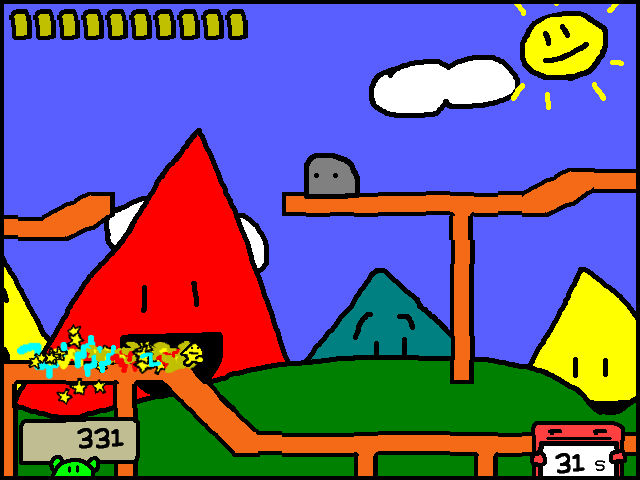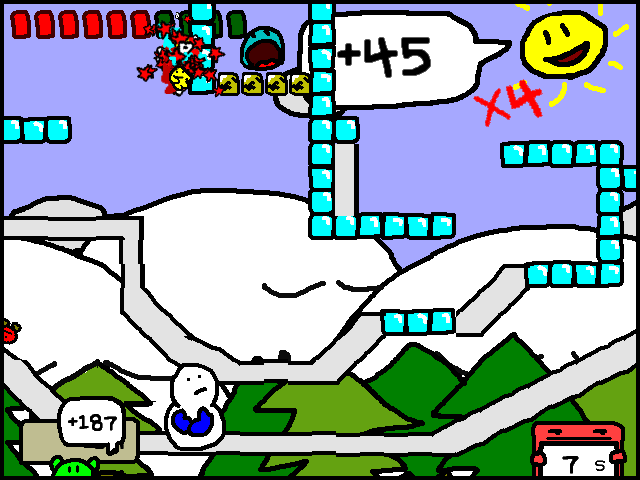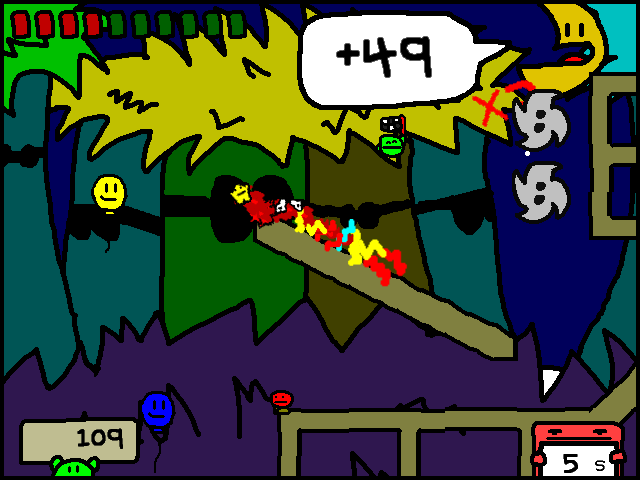I must confess that, despite my love for Sega and platform games and all things big and glorious, I have quite a soft spot for indie games, especially of the $free.99 variety. Therefore, I was already sold when a friend brought up Runman: Race Around the World as a title worth checking out. The game, developed by Tom Sennett and Matt Thorson, has a simple enough premise: Runman, a star-like creature, enters a contest to be the fastest creature in the world; when the other inhabitants of Runman’s world see he’s signed up, they all drop out and Runman is the winner by default. However, our protagonist, not content to win on technicality, sets out to prove that he’s the fastest guy out there.
The basic premise of the game is for Runman to clear levels in a variety of locations as he races around the world. Gameplay is quite simple: players use directional keys, along with a jump and boost button, to navigate through the stages, but the sheer variety of obstacles, enemies and hazards lends to a speedy mix of play: wall-jumping to launch to higher areas, using strategically-placed balloons to take air routes, or sleeping enemies that players must slow down to pass are par for the course. Though the game has “bottomless pits,” the play mechanic bounces Runman back out at the cost of his speed–an effective solution to a problem encountered in Sonic games. Giant monsters chasing you? It’s got it. Icy terrain? It’s got it. Crazy vine-swinging antics? It’s got it.
Sennett and Thorson use a deceptively clever MSPaint aesthetic that brings a nostalgic charm to the game; bright, colorful landscapes make the game intuitive to new players and little touches of fancy (like the mountains of the first world breaking out in grins when Runman reaches maximum speed) keeps what could be a repetitive style fresh. The game uses public domain music from a variety of genres including blues, folk and jazz that provides polish and a light mood overall.
Additionally, the game has quite a bit of replay built-in: secret unlockable characters, medal score challenges and a ghost save function to trade and challenge your friends against your best performances. Overall, the game is an amazingly solid and incredibly fun experience–and something I think the Sonic series could learn from.
In the advent of Sonic 4: Episode I‘s release this fall, Runman stands as a great alternative to 2D speed-based platforming. Physics aren’t that difficult to execute when things are kept simple and sweet and a strong emphasis is placed on the player’s reaction to the environment. Add another layer or two of branching paths and the game would play almost exactly like a Sonic game. Using a cohesive artistic identity makes the game feel like one tightly-knit world and the Kirby’s Adventure-like world map reinforces the idea of what is in fact Runman’s entire world. Heck, you can literally run around his Sonic CD-esque planet! Whether this game inspires Sonic Team developers or sparks the imagination of fangame creators, it’s definitely a great template for the Sonic world to learn from.
You can download Runman: Race Around the World at http://whatareyouwait.info/ and can even throw the developers a few bucks on PayPal if you think it’s worth it (and I certainly think it is. 😉 ) What sort of things do you think can Sonic games learn from titles like this, and in turn, what does Sonic excel at that you would suggest to improve the game?



5 Comments
I wouldn’t want a sonic game to play like this. Sure, its a cool concept. I’ve played it. But sonic needs more emphasis on platforming.
LOVED IT!
it reminds me of playing Sonic Adventure 2’s speed stages, cause it’s easy to get through the stages, but takes some form of skill to get the highest rank, or in this case, the gold medal.
Overall, it’s awesome.
I love Runman! What a surprise to see it featured here.
Though Runman is based around speed, and Sonic is based around speed (at least in popular conception), I don’t find them very similar even though I like them both. I don’t think much would be added to either if they were “cross-pollenate”.
Perhaps Runman-style Special Stages would be cool in a Sonic game, but aside from that, I think Sonic games should move AWAY from the run-run-run gameplay that makes Runman so charming.
One of the most famous and loved sequences in all of Sonic is the Lava Reef through Death Egg sequence, and when evaluating it today it’s clear that the emphasis is on jumping and rolling and not running in particular.
Maybe I should try to put the distinction as I see it more succinctly: In Runman, you don’t think much about how you’re moving, and it’s more about reacting to what comes into view. In Sonic the opposite is true – there’s no need to immediately respond to what appears on the screen, and your entire attention is focused on Sonic’s finetuned movement. To me, the gameplay styles are opposite, and this might be what causes Advance and Rush to leave people feeling unsatisfied – it tries to combine polar opposites and neither remain unscathed.
Now this is what sonic shud be. Its not slow…but its not Hold right and win either. 😀
Fancy Pants Adventures.
http://www.youtube.com/watch?v=tP5wREJFKUU
That’s all I have to say.